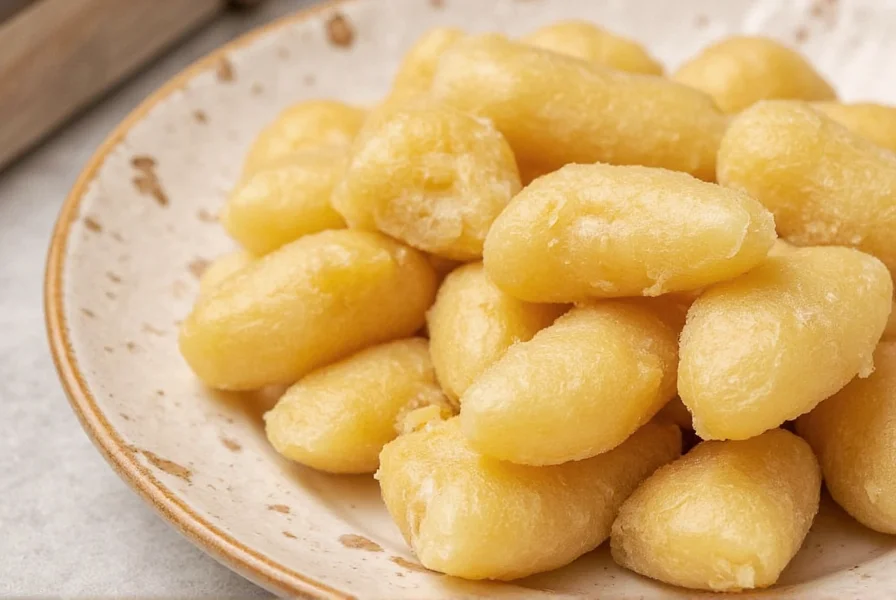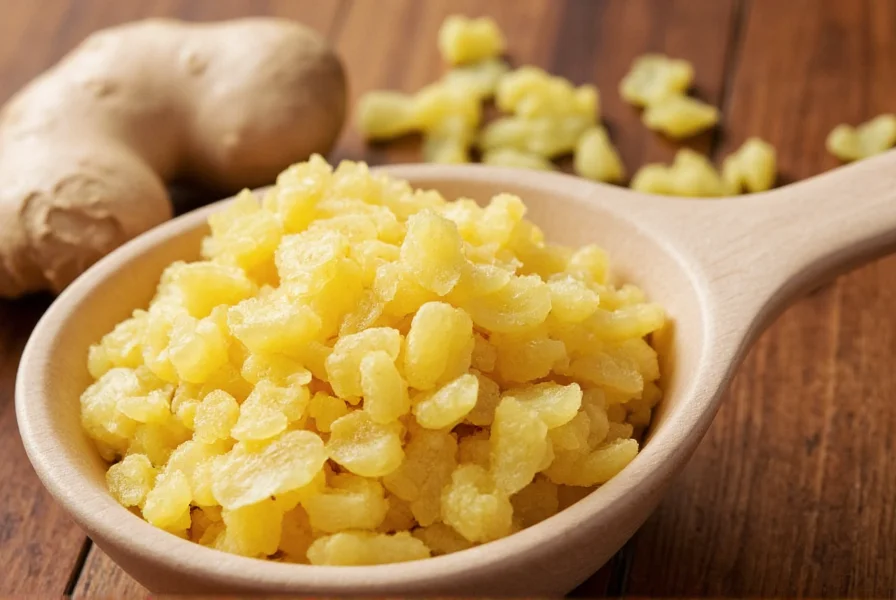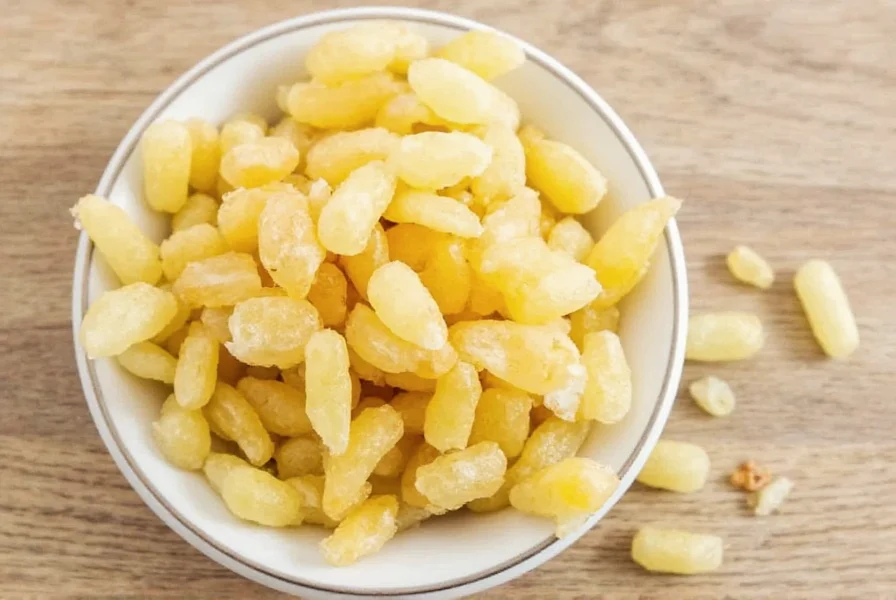Crystallized ginger, also known as candied ginger, represents one of the most versatile preparations of the popular Zingiber officinale root. This distinctive product transforms fresh ginger through a preservation process that creates a shelf-stable ingredient with unique culinary applications and potential wellness properties. Understanding what crystallized ginger is and how to use it properly can enhance both your cooking and informed dietary choices.
What Exactly Is Crystallized Ginger?
Crystallized ginger begins as fresh ginger root that undergoes a careful cooking process in sugar syrup, followed by coating in additional sugar crystals. This preservation method creates a product with several distinctive characteristics:
| Characteristic | Crystallized Ginger | Fresh Ginger |
|---|---|---|
| Texture | Chewy, firm | Crisp, fibrous |
| Shelf Life | 6-12 months | 1-3 weeks |
| Sugar Content | High (added sugar) | Natural sugars only |
| Gingerol Concentration | Moderate (some loss during processing) | High |
The Traditional Production Process
Creating quality crystallized ginger involves several precise steps that preserve ginger's beneficial compounds while developing its distinctive sweet-spicy profile. The traditional method includes:
- Peeling and slicing fresh ginger into uniform pieces
- Simmering in sugar syrup (typically 1:1 sugar to water ratio) for several hours
- Multiple cooking cycles with gradually increasing sugar concentration
- Drying period to allow sugar crystallization on the surface
- Final coating in fine sugar crystals for texture
Commercial producers often use vacuum cooking techniques to preserve more of ginger's volatile compounds while achieving the desired texture. The best crystallized ginger maintains a balance between sweetness and ginger's characteristic heat, with a translucent appearance indicating proper syrup penetration.

Culinary Applications of Crystallized Ginger
Professional chefs and home cooks value crystallized ginger for its concentrated flavor and versatility. Unlike fresh ginger, which loses potency when cooked, crystallized ginger maintains its distinctive taste through various preparation methods. Consider these creative uses:
- Baking enhancement - Finely chopped crystallized ginger adds depth to cookies, cakes, and breads
- Savory dish accent - Small pieces complement stir-fries, glazes for meats, and vegetable dishes
- Infused beverages - Steep pieces in hot tea or add to cocktail syrups
- Trail mix component - Combines well with nuts and dried fruits
- Chocolate pairing - Creates sophisticated flavor combinations in desserts
When substituting crystallized ginger for fresh in recipes, remember that its sugar content affects both flavor and texture. For every tablespoon of fresh ginger, use approximately 1.5 tablespoons of finely chopped crystallized ginger while reducing other sweeteners in the recipe.
Nutritional Profile and Potential Wellness Benefits
While crystallized ginger contains added sugars, it retains some of fresh ginger's bioactive compounds. A typical 1-ounce (28g) serving contains approximately:
- Calories: 100-120
- Sugar: 20-25g
- Dietary fiber: 1-2g
- Gingerols: 5-10mg (varies by processing method)
Research suggests gingerols may support digestive health and provide antioxidant effects, though crystallized ginger's higher sugar content means these potential benefits must be weighed against overall dietary goals. Unlike ginger supplements, crystallized ginger offers these compounds in food form with naturally occurring co-factors that may enhance bioavailability.
Individuals managing blood sugar should consume crystallized ginger in moderation due to its sugar content, while those seeking ginger's potential digestive benefits might prefer it over supplements for its more gradual release of active compounds.
Selecting and Storing Quality Crystallized Ginger
When choosing crystallized ginger, look for these quality indicators:
- Bright golden color without dark spots
- Moist but not sticky texture
- Clear ginger flavor without chemical aftertaste
- Minimal additional ingredients beyond ginger, sugar, and sometimes citric acid
Proper storage extends crystallized ginger's shelf life significantly. Keep it in an airtight container away from direct sunlight at room temperature for up to six months. For longer storage, refrigeration can extend freshness to one year. Avoid humid environments, as moisture causes the sugar coating to dissolve.

Crystallized Ginger Compared to Other Ginger Forms
Understanding how crystallized ginger differs from other preparations helps determine the best use for each:
- Fresh ginger - Higher gingerol content, more pungent, better for immediate consumption or cooking where texture matters
- Dried ginger powder - Concentrated flavor, convenient for baking, but loses some volatile compounds
- Preserved ginger (in syrup) - Similar to crystallized but stored in liquid, less shelf-stable
- Ginger extracts - Highest concentration of active compounds, but lacks food matrix benefits
For those exploring crystallized ginger benefits versus fresh ginger, consider that crystallized offers convenience and shelf stability at the cost of added sugar, while fresh provides maximum potency with shorter usability.
Practical Considerations for Daily Use
Incorporating crystallized ginger into your routine requires thoughtful consideration of both benefits and limitations. As a flavorful addition to your pantry, it offers unique advantages when used appropriately. Those interested in how to use crystallized ginger in cooking will find it particularly valuable for adding depth to both sweet and savory dishes without the moisture content of fresh ginger.
When exploring crystallized ginger nutritional value, remember that while it contains beneficial compounds, its sugar content means moderation is key. For those seeking ginger's potential wellness properties without excess sugar, consider using smaller amounts of higher-quality crystallized ginger or alternating with fresh preparations.
What is the difference between crystallized ginger and candied ginger?
Crystallized ginger and candied ginger refer to the same product. The terms are used interchangeably to describe ginger root preserved in sugar syrup and coated with sugar crystals. Some manufacturers use 'crystallized' to emphasize the sugar crystal coating, while 'candied' refers to the candy-like quality.
Does crystallized ginger have the same health benefits as fresh ginger?
Crystallized ginger retains some, but not all, of fresh ginger's beneficial compounds. The cooking process preserves certain gingerols while reducing others. However, the added sugar content means crystallized ginger should be consumed in moderation compared to fresh ginger, especially for those monitoring sugar intake.
How can I make crystallized ginger at home?
To make homemade crystallized ginger, peel and slice fresh ginger, then simmer in a sugar-water solution (1:1 ratio) for 1-2 hours. Increase sugar concentration gradually over multiple cooking sessions, then drain and coat in additional sugar. Allow to dry for 24-48 hours until the sugar crystallizes on the surface.
Is crystallized ginger suitable for people with diabetes?
Due to its high sugar content, crystallized ginger should be consumed in very small quantities by people with diabetes. A single piece (about 1 inch) contains approximately 5-7 grams of sugar. Those managing blood sugar levels might prefer fresh ginger or ginger tea as lower-sugar alternatives while still benefiting from ginger's properties.
What's the best way to store crystallized ginger to maintain freshness?
Store crystallized ginger in an airtight container away from direct sunlight at room temperature for up to six months. For extended storage up to one year, keep it in the refrigerator. Avoid humid environments as moisture causes the sugar coating to dissolve. Properly stored crystallized ginger should remain moist but not sticky with a clear ginger flavor.











 浙公网安备
33010002000092号
浙公网安备
33010002000092号 浙B2-20120091-4
浙B2-20120091-4